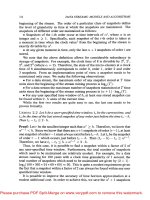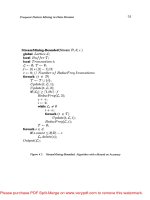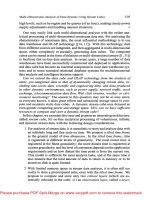fracture mechanics of concrete concepts, models and determination of material properties
Bạn đang xem bản rút gọn của tài liệu. Xem và tải ngay bản đầy đủ của tài liệu tại đây (351.49 KB, 2 trang )
ACI
446.1 R
-
91
(Reapproved
1999)
An
abstract:
Fracture Mechanics
of
Concrete:
Concepts, Models and Determination
of
Material Properties
Reported
by
ACI Committee
446,
Fracture Mechanics*
ZdenBk P. Bhd2
Chairman
Oral Buyukozturk'
Luigi
Cedolin'
David Darwin3
Manuel
el ice^'^
Shu
-
Jin Fang
Walter Gerstles
Neil M. Hawkins
Hideyuki Horii'
Jeremy Isenberg
Victor
C
.
Li'
Feng
-
Bao Lin'
Steveh
L.
McCabe
Sheng
-
Taur Mau3
Jacky Mazars3
Sidney Mindess
Antoine
E.
Naaman'
C.
Dean Norman
Phillip
A.
Pfeiffer
Vellore
S
.
~opalaratnam'J
Secretary
Gilles
Pijaudier-Cabot3
Victor Saouma'f
Surendra P. Shah13
Robert L. Sierakowski
Wimal
Suaris'
Stuart
E.
Sward2
Tatsuya Tsubaki
C.
Vipulanandan'
Methi Wecharatana'
The
committee wishes
to
recognize the contributions
of
the following non
-
voting members:
Farhad
Ansari'
Ravindra Gettu3
g'
Arne Hillerbor
B.L. Karihaloo
1
Members
of
Subcommittee I (chaired by Batant) which prepared the report
2
Principal Authors
3
Contributing Authors
ACI
Committee Reports, Guides, Standard Practices. and Commentaries
are intended for guidance in planning. designing, executing. and inspecting
construction. This document is intended for the use of individuals who
are competent to evaluate the significance and limitations of its con-
tent and recommendations and who will accept responsibility for the
application of the material it contains. The American Concrete Institute
disclaims any and all responsibility for the stated principles. The Institute
shall not be liable for any loss or damage arising therefrom.
Reference
to
this document shall not be made in contract documents. If
items found in this document are desired by the
Architecangineer
to
be
a
part of the contract documents. they shall be restated in mandatory lan-
guage for incorporation by the
ArchitectEngineer.
Pere
C
.
Prat'
Hans W. Reinhardt'
This
report
was
approved
by
a vote
of
the
full
ACI Committee
446
The
full
report
of
ACI 446.1R-91
u
available
as
a separate publi
-
Copyright
0
1991,
American Concrete Institute.
All rights reserved
including the
rights
of
reproduction and
use
in any
form
or
by any means,including the making
of
copies by any photo pro-
cess,
or by any electronic or mechanical device, printed, written, or oral,
or recording for sound
or
visual reproduction or for
use
in
any
know
-
ledge or retrieval system
or
device, unless permission
in
writing
is
obtained from the copyright proprietors.
in
December
1989.
It doer
not
reflect research after that date.
cation.
446.1
R-1
446.1
R
-
2
MANUAL
OF
CONCRETE PRACTICE
SY
N
OPSlS
In the first of
its
series
of
four state
-
of
-
the
-
art reports under preparation,
the
Committee describes
the basic concepts
of
fracture mechanics of concrete, the existing theoretical models, and the methods
for determining the material fracture parameters. Chapter
1
offers five reasons for introducing fracture
mechanics into certain aspects of design of concrete structures, including some code provisions:
(1)
a
theoretical energy argument;
(2)
the need to achieve objectivity of finite element solutions, i.e., eliminate
spurious mesh sensitivity;
(3)
the progressive (propagating) nature
of
failure, implied whenever the load-
deflection diagram lacks a yield plateau;
(4)
the need to rationally predict ductility and energy absorption
capability; and most importantly,
(5)
the effect
of
structure size on the nominal strength (i.e., nominal
stress at maximum or ultimate load) as well as on ductility and energy absorption capability. The
size effect
is
due to stored energy release into the fracture front, and
is
not governed by Weibull
-
type
statistical theory. Experimental evidence on the existence
of
the size effect, hitherto ignored in design
practice and code provisions,
is
documented.
Chapter
2
gives a brief review of the necessary basic results of linear elastic fracture mechanics
(LEFM).
In concrete, departures from
this
classical theory are caused by the existence of distributed
cracking (or damage) in a progressively softening fracture process zone which surrounds the tip of a con
-
tinuous crack. In Chapter
3
nonlinear fracture models characterizing
the
softening stress
-
displacement
or stress
-
strain relations (such as those of Hillerborg's fictitious crack model, crack band model, nonlocal
strain
-
softening models, etc.) are described and random particle simulation of aggregate microstruc
-
ture
is
discussed. The principles of implementation
of
these models in finite element programs are also
outlined. Chapter
4
presents simpler nonlinear fracture models which represent adaptations of linear
elastic fracture mechanics, such as Jenq and Shah's model and the R
-
curve, along with determination
of
geometry
-
dependent R
-
curves from the size effect law proposed by Barant. This law, describing
the approximate dependence of the nominal stress at maximum load on structure size,
is
discussed in
Chapter
5,
and structural response
is
characterized by the brittleness number.
Chapter
6
presents in considerable detail
the
current methods for experimental and analytical deter
-
mination of material fracture parameters, including the quasi
-
LEFM methods,
RILEM
(work
-
of
-
fracture)
method, the Jenq
-
Shah and Karihaloo
-
Nallathambi methods, and the size
-
effect method. Experimen
-
tal determination of the characteristic length for nonlocal continuum models and the strain
-
softening
properties
is
then examined, and material parameters for modes
II
and
Ill,
shear fractures and mixed
mode fracture are also discussed. Chapter
7
then proceeds
to
describe various influencing factors, such
as the loading rate, humidity and temperature, as well as the effect of cyclic loading. Chapter
8
is
devoted to the effect
of
reinforcing bars and their bond slip on fracture propagation, and to fracture
of
fiber
-
reinforced concrete. Chapter
9
deals with more theoretical problems
of
modeling systems of
interacting cracks. Attention
is
focused on systems of parallel growing cracks. Their stability decides
the
spacing and width
of
the cracks from the mechanics viewpoint.
It
is
concluded that, after a decade of rapid progress in research, the time appears ripe
for
introducing
fracture mechanics into design practice.
This
should not only bring about more uniform safety margins,
thus
improving safety and economy of design, but also pave the way for safer and more efficient use of
high
-
performance concretes and permit design extrapolations beyond
the
range of previous experiments
and design.
KEYWORDS
:
Brittleness, concrete, concrete structures, crack spacing and width
,
cracking, damage
mechanics, design codes, ductility, failure, fiber
-
reinforced concrete, nonlocal continuum models,
reinforced concrete, size effect, strain softening, structural
design, testing methods, ultimate loads.









